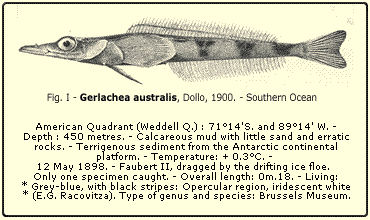|
|
|
|
Fish living in the cold Of the 20,000 species of fish known in the world, only 270 frequent the Antarctic waters. One of the reasons for this poverty resides in the fact that the continental platforms - which in normal configurations of depth are areas of high fish density - go down more deeply than normal, between 500 to 700 metres instead of between 150 to 200 metres in the other parts Their principal characteristics reside in their astonishing adaptation to the cold that their organisms have been able to develop throughout the ages. Certain species even possess anti-freeze molecules - a kind of glycol - that seem to block any formation of ice in their bodily fluids. Others have a metabolism that is remarkably well adapted to the cold. But the strangest thing is that the latter does not at all slow down the essential vital functions such as mobility or feeding, as one might have expected; these fish swim, in effect, just as quickly and feed just as much as the majority of other fish throughout the world. Which means that their enzymes as well have had to travel an astonishing path to adapt to their new conditions of life. One of the best known families of fish in the Antarctic is the "Fish of the Ice" (the Channichthyidae). Its notoriety is due to the fact that it is the only group of vertebrates in the world without haemoglobins; these fish are said to have white blood. Oxygen having as a result to be conveyed by other means (among other, plasma) its circulation is diminished by 90% in comparison with the other species living in the same environment, despite the fact that its heart is twice as large as normal, that it works twice as hard (by not twice as fast) and that the volume of its blood is 3 to 4 times higher than that of its conspecifics.
|

 of the world (this would be due to the fact that the continent is sinking and that it is sinking further under the weight of the ice); fish accustomed to living in shallow water, which are moreover extremely numerous, are therefore very rare in the Southern Ocean. On the one hand, some abyssal species are known to exist as catches have been made in the Weddell Sea at a depth of 4,500 metres. The benthic fish (that is to say fish living on or near the bottom) that make up 75% of the Antarctic species can be divided into two groups: those living at a depth of 500 to 700 metres on the continental platform - which is the majority - and those living at a deeper level, on the continental slope of the abyssal plain.
of the world (this would be due to the fact that the continent is sinking and that it is sinking further under the weight of the ice); fish accustomed to living in shallow water, which are moreover extremely numerous, are therefore very rare in the Southern Ocean. On the one hand, some abyssal species are known to exist as catches have been made in the Weddell Sea at a depth of 4,500 metres. The benthic fish (that is to say fish living on or near the bottom) that make up 75% of the Antarctic species can be divided into two groups: those living at a depth of 500 to 700 metres on the continental platform - which is the majority - and those living at a deeper level, on the continental slope of the abyssal plain.